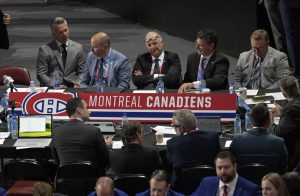The San Jose Sharks made a major splash this summer with the acquisition of elite offensive defenseman Erik Karlsson. Karlsson spent the entirety of his nine-year career with the Ottawa Senators prior to the trade. Now a Shark, Karlsson joins an already-strong blueline group. San Jose has two of the top defensemen in the entire league now, as incumbent Brent Burns also ranks near the top of the league for his position. Burns and Karlsson make for an incredibly dynamic duo and makes the Sharks an incredibly dangerous team.
As great as this is for the Sharks and their fans, it may not bode as well for fantasy owners. Karlsson produces at or near a point-per-game pace every year, a pace that Burns has been just behind for the last five or so seasons. With both men fighting for the same team, though, it could be hard for both to achieve the same level of individual success.
Brent Burns, Erik Karlsson May Eat into Each Other’s Stat Lines
As of today, Monday 10/15, the Sharks sit six games into their 82-game season. I’m not going to try and claim this to be an accurate sample for the year as a whole, but their start is still worth noting. San Jose is 2-3-1, with 17 goals for and 19 goals against. That means they’re scoring just under three goals per game while surrendering just over three per game.
Over the course of the full year, the goals against number will likely decrease. Goaltender Martin Jones has been one of the most consistent guys over the last three seasons. The .880 save percentage he’s currently sporting won’t stay that low for too long. Of course, Burns and Karlsson will help that happen, but their depth on defense doesn’t stop there. Each of Marc-Edouard Vlasic, Justin Braun, and Brenden Dillon bring a lot to the table too, and Vlasic might be one of the top defensive d-men in the league.
The bigger question is how much offense will these guys supply to the Sharks from the blue line?
Sharing the Top Power Play
So far, it appears the Sharks plan to continue deploying Burns and Karlsson together on the first powerplay unit. While this does allow them to both receive quality power play opportunities, it might still mean they each produce less individually. That can happen even if adding Karlsson results in a better powerplay, as they just end up splitting the scoring.
Let me illustrate with an example. Let’s say the Sharks powerplay sees a 5% improvement with the addition of Karlsson to the roster. A 5% bump would be awesome, as they finished with a 20.6% clip in 2017-18. Increasing that to 25.6% would’ve been good for the second-best power play in the NHL last year, a half of a percent below the Pittsburgh Penguins (26.1%).
Drilling Down on the Numbers
Now, let’s look at what Burns and Karlsson did on the man advantage last year. Karlsson potted three goals and 15 assists for the Ottawa Senators’ power play last season, while Burns finished with five goals and 22 assists for the Sharks’ power play. Ottawa scored a grand total of 41 powerplay goals, meaning Karlsson factored in on 43.9% of the team’s powerplay success. Burns did the same on 50.9% of the Sharks’ 53 powerplay goals.
If the Sharks get another 257 powerplay opportunities, the same number they did last season, they should score 66 powerplay goals. That is, of course, using the “5% increase” we assumed Karlsson would provide to the Sharks powerplay production. If both players factor in on the same portion of power play goals that they did last season, Burns would net 34 powerplay points, while Karlsson nets 29.
If Burns and Karlsson are on the same unit, though, they might end up with fewer assists individually. As defensemen, the vast majority of their powerplay production is via assists. Only two assists can be credited per goal as a maximum, and not every goal scored will have two assists either. The only way they both get credit for assists is if Burns passes it to Karlsson, or vice-versa, and then the next Shark to touch the puck scores the goal.
Reduced Individual Stats, But Increased Team Production
Re-visiting their stats from last season, its impossible to imagine Karlsson and Burns factor in to the same percentage of the team’s powerplay goals as they have in the past. Karlsson’s 43.9% and Burns’ 50.9% equals 94.8% cumulatively; this would be if they factored in on none of the same goals. But we know this won’t happen because they’re playing on the same powerplay unit.
There’s no way they separately account for almost every single power-play goal. San Jose has so many forwards who produce at high rates, and not every powerplay goal includes a defenseman on it. (This is obvious already, as Burns and Karlsson are both around 50% as the league’s top offensive defensemen). The Sharks will have plenty of powerplay goals with neither Burns or Karlsson on the scoresheet, as Logan Couture, Tomas Hertl, Joe Pavelski, and the entire second unit, will score goals and get assists too.
Adding Value with Presence
So, how then can Karlsson provide a bump to the team’s production while he and Burns reduce each other’s individual stats? Well, the team didn’t have any of Karlsson’s production last year, so adding him brings new points no matter what. Even if he adds just 85% of his usual year-to-year scoring, that’s 85% elite production the team didn’t have before. Granted, it probably reduces Burns’ scoring as discussed too, but two elite guys at 85% are better than one at 100%. Right?
Right. A lot of the value the two provide the team won’t appear under their personal stat line like it has in the past. They’ll still both score a lot and be among the league’s top for defensive scoring, but might not run away with those categories as they’ve been able to in the past. San Jose will benefit, though, from the threat Karlsson adds.
Powerplay Presence
Opponents now have to respect both point options on the Sharks top powerplay unit. Both Karlsson and Burns have the capability to score or create excellent plays, so there’s no cheating to one side or the other for an opponent’s penalty kill. Karlsson himself may not factor in on 50% of the team’s powerplay goals, nor will Burns reach his 44% clip again. But, the whole team will do better thanks to having him as an asset.
The benefit trickles down to the second unit, too. Now they can afford to skate Vlasic as the only defenseman on that unit, and Evander Kane joins that group too. It might seem to be a demotion for him, going from the first group to the second, but it again makes their depth on the power play that much stronger. Opponents have to be sure they are prepared for the second group as much so as the first.
San Jose should get higher production from the second unit now, again helping raise their conversion percentage. That represents part of the “5% increase” we expect to see with Karlsson joining the team, and clearly it is production he himself doesn’t add. Adding him to the team as a whole enables them to collectively increase their production.
“Good” Numbers for Burns and Karlsson
It should be acceptable to fans, then, to see Burns and Karlsson produce less than what they have typically done in the past. The “dip” in individual performance will be strictly statistical, as they’ll be providing the team with the same level of play as they always do. The team should be better overall thanks to having them both, its just unlikely the team scores 150 points from the blue line between two defensemen. Whether the powerplay improves by 5% or 1%, it needs to take a step forward to some degree in order to make adding Karlsson worthwhile.
So far, through the first six games of the season, Karlsson has three assists to Burns’ four. Neither has a goal yet. Over a full year, this pace would mean 41 points for Karlsson and 55 for Burns, both of which would be their lowest totals in five or more seasons. Again, the team is 2-3-1 and will probably improve drastically before the year ends.
San Jose should definitely make playoffs this year, and they’re built for a deep playoff run. Their defense is among the league’s best, and as a committee that group has the potential to pace the entire league. It could even be one of the highest scoring defensive groups in modern NHL history, should everything go well. From a fantasy hockey perspective, though, it could mean tempering individual expectations for the guys on the Sharks blueline. Expect both Burns and Karlsson to score more than they have so far, but maybe not as much as they have in recent years.
Main Photo:
Embed from Getty Images






